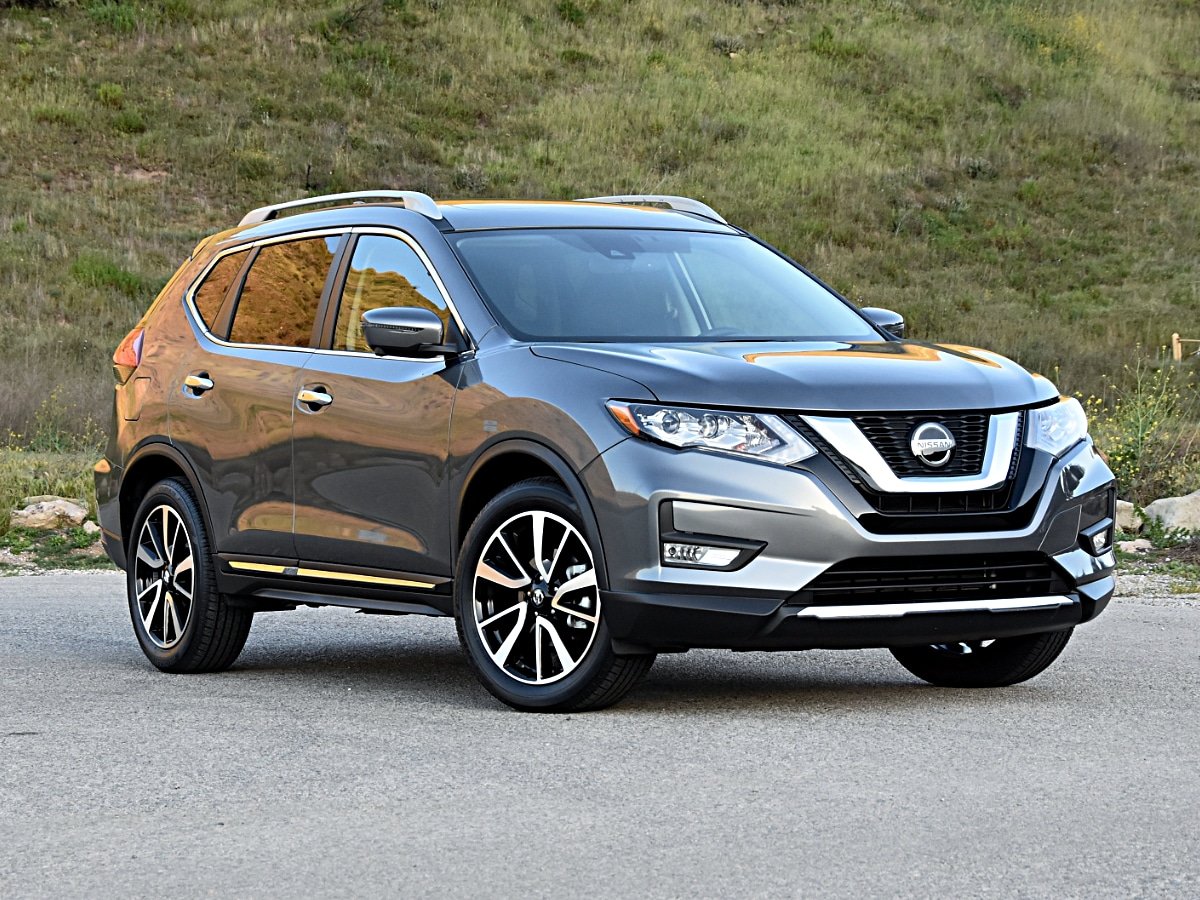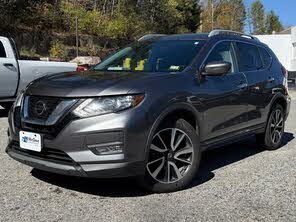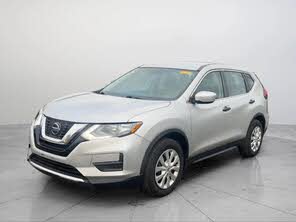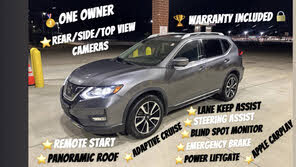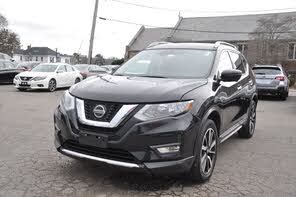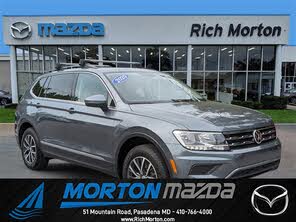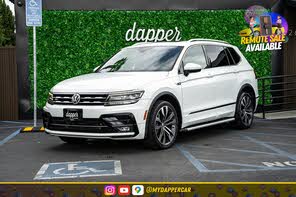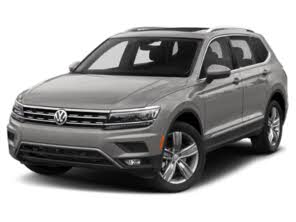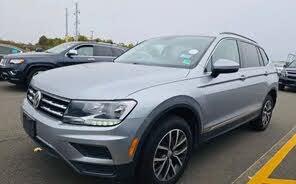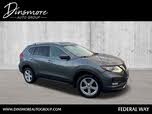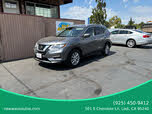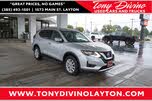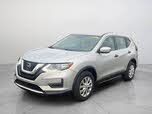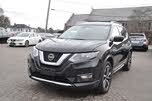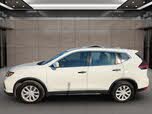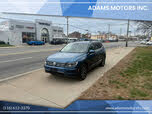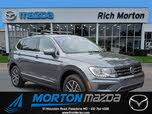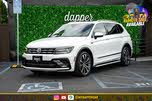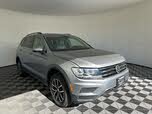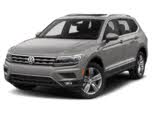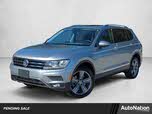2020 Nissan Rogue vs 2020 Volkswagen Tiguan
Overview | |
MSRP$25,490 | MSRP$24,945 |
Listings1166 | Listings907 |
Ratings & Reviews | |
User Reviews | User Reviews |
Expert reviews6.0 out of 10 | Expert reviews7.7 out of 10 |
Pros
Cons
| Pros
Cons
|
2020 Nissan Rogue Reviews SummaryNissan hasn’t redesigned the Rogue since 2014, but an all-new version of this SUV is coming for the 2021 model year. In the meantime, dealers will be eager to sell remaining stocks of the outgoing 2020 Nissan Rogue, and the deals on these new cars ought to be mighty juicy. Should you bite? Should you wait? Or should you shop for something else? The answers to these questions depend on who you are and what you value in a compact crossover SUV. | |
2020 Volkswagen Tiguan Reviews SummaryThe Volkswagen Tiguan is one of only two compact crossover SUV’s that currently offer third-row seating. (And the other is the hopelessly outdated Mitsubishi Outlander.) To fit the extra pair of surprisingly spacious seats, VW made the Tiguan much larger than average for its competitive set—which suits a vehicle that fills big shoes in VW dealerships. With five trim levels and prices that stretch from just under $26,000 to a bit over $40,000, the Tiguan is the German brand’s best-selling vehicle in the U.S. | |
No video found | No video found |
Popular Features & Specs | |
Engine2.5L 170 hp I4 | Engine2.0L 184 hp I4 |
Drive TrainFWD | Drive TrainFWD |
Seating Capacity5 | Seating Capacity7 |
Horsepower170 hp @ 6000 rpm | Horsepower184 hp @ 4400 rpm |
MPG City26 | MPG City22 |
MPG Highway33 | MPG Highway29 |
Engine | |
Engine Name2.5L 170 hp I4 | Engine Name2.0L 184 hp I4 |
Torque175 lb-ft @ 4400 rpm | Torque221 lb-ft @ 1600 rpm |
Horsepower170 hp @ 6000 rpm | Horsepower184 hp @ 4400 rpm |
DrivetrainFWD | DrivetrainFWD |
Fuel Economy | |
MPG City26 | MPG City22 |
MPG Highway33 | MPG Highway29 |
Interior | |
Seating Capacity5 | Seating Capacity7 |
Safety | |
Front Crash Overall4 | Front Crash Overall4 |
Side Crash Overall5 | Side Crash Overall5 |
Dimensions & Capacity | |
Cargo Space39.3 cu ft | Cargo Space12.0 cu ft |
Curb Weight3463 lbs | Curb Weight3757 lbs |
Height66.3 in | Height66.3 in |
Length184.5 in | Length185.1 in |
Width72.4 in | Width72.4 in |
Wheelbase106.5 in | Wheelbase109.8 in |
Maximum Payload1127 lbs | Maximum Payload1124 lbs |
Number of doors4 | Number of doors4 |
Maximum Towing Capacity | Maximum Towing Capacity1500 lbs |
Overview | ||
MSRP | $25,490 | $24,945 |
Listings | ||
Ratings & Reviews | ||
User reviews | ||
Expert reviews | 6.0 out of 10Read full review | 7.7 out of 10Read full review |
Pros & cons | Pros
Cons
| Pros
Cons
|
Summary | Nissan hasn’t redesigned the Rogue since 2014, but an all-new version of this SUV is coming for the 2021 model year. In the meantime, dealers will be eager to sell remaining stocks of the outgoing 2020 Nissan Rogue, and the deals on these new cars ought to be mighty juicy. Should you bite? Should you wait? Or should you shop for something else? The answers to these questions depend on who you are and what you value in a compact crossover SUV. | The Volkswagen Tiguan is one of only two compact crossover SUV’s that currently offer third-row seating. (And the other is the hopelessly outdated Mitsubishi Outlander.) To fit the extra pair of surprisingly spacious seats, VW made the Tiguan much larger than average for its competitive set—which suits a vehicle that fills big shoes in VW dealerships. With five trim levels and prices that stretch from just under $26,000 to a bit over $40,000, the Tiguan is the German brand’s best-selling vehicle in the U.S. |
Video | No video found | No video found |
Popular Features & Specs | ||
Engine | 2.5L 170 hp I4 | 2.0L 184 hp I4 |
Drive Train | FWD | FWD |
Seating Capacity | 5 | 7 |
Horsepower | 170 hp @ 6000 rpm | 184 hp @ 4400 rpm |
MPG City | 26 | 22 |
MPG Highway | 33 | 29 |
Engine | ||
Engine Name | 2.5L 170 hp I4 | 2.0L 184 hp I4 |
Torque | 175 lb-ft @ 4400 rpm | 221 lb-ft @ 1600 rpm |
Horsepower | 170 hp @ 6000 rpm | 184 hp @ 4400 rpm |
Drivetrain | FWD | FWD |
Fuel Economy | ||
MPG City | 26 | 22 |
MPG Highway | 33 | 29 |
Interior | ||
Seating Capacity | 5 | 7 |
Safety | ||
Front Crash Overall | 4 | 4 |
Side Crash Overall | 5 | 5 |
Dimensions & Capacity | ||
Cargo Space | 39.3 cu ft | 12.0 cu ft |
Curb Weight | 3463 lbs | 3757 lbs |
Height | 66.3 in | 66.3 in |
Length | 184.5 in | 185.1 in |
Width | 72.4 in | 72.4 in |
Wheelbase | 106.5 in | 109.8 in |
Maximum Payload | 1127 lbs | 1124 lbs |
Number of doors | 4 | 4 |
Maximum Towing Capacity | 1500 lbs | |
The 2020 Nissan Rogue was available in S, SV, and SL trim levels with a singular engine and transmission combination and an option between front-wheel drive (FWD) and all-wheel drive (AWD). The test model featured SL trim, front-drive, an SL Premium Package, carpeted floor and cargo mats, and a first-aid kit, with a window sticker price of $34,870 including a $1,095 destination charge.
Visually, the Rogue remained attractive despite its age. The bold V-Motion grille and fender swells were somewhat exaggerated, but the 19-inch aluminum wheels on the SL trim added to its appeal.
Inside, the Rogue's design showed its age with an outdated waterfall control panel and rounded interior surfaces. The plastic surfaces also lacked premium touch. However, the padded sides of the center console were a thoughtful touch for driver comfort.
Contrastingly, Volkswagen had completely overhauled the Tiguan for the 2018 model year, introducing a second generation of its compact crossover SUV. This model retained stylish, conservative German aesthetics. The front fascia featured a horizontal grille adorned with VW's new flat logo, connecting the headlights harmoniously. The design was straightforward and modern, showcasing Volkswagen’s preference for cars that look like cars.
Inside, the Tiguan’s interior might have seemed plain and uninspiring compared to the outstanding interiors VW was known for in the past. The cockpit was simple to the point of being boring, with dull surfaces and hard black plastic that did not live up to the brand’s legacy. However, it featured impressive electronics—specifically, the optional digital dashboard and a glass-covered touchscreen infotainment system which were both user-friendly and visually appealing.











The 2020 Nissan Rogue came equipped with a single 2.5-liter four-cylinder engine producing 170 horsepower, paired with a continuously variable automatic transmission (CVT). Although the Rogue did feature a Sport driving mode, it was not particularly sporty. At a weight of up to 3,671 pounds, the Rogue was merely adequate in terms of performance.
Most Rogue owners might not have noticed the lack of power in daily driving, thanks to the CVT's ability to maximize the limited output. However, during freeway acceleration, overtaking slower vehicles, or climbing steep grades, the Rogue’s response was more noise than action. Despite the EPA’s combined driving rating of 29 mpg for FWD models, the actual fuel efficiency was disappointing, achieving only 24.9 mpg during tests.
Dynamically, the Rogue featured brake-induced Intelligent Trace Control and Active Ride Control technologies that improved handling and comfort. Nevertheless, its heavy and lifeless electrically assisted steering, lack of suspension isolation, and occasional CVT drone made driving it more about endurance than enjoyment.
The 2020 Volkswagen Tiguan featured a turbocharged 2.0-liter four-cylinder engine generating 184 horsepower and 221 pound-feet of torque. Its eight-speed automatic transmission drove either the front or all four wheels, with the AWD option adding $1,300 to the price.
With a curb weight between 3,757 and 3,847 pounds, the Tiguan was larger and heavier than competitors like the Honda CR-V. Despite its size, the Tiguan’s powertrain offered a snappy throttle response and minimal turbo lag. However, when fully loaded, it required patience during highway passing maneuvers. Unlike the Rogue, the Tiguan’s engine sound was subdued and refined, and the cabin provided a quiet cruising experience on the highway, though some road noise permeated through rough surfaces.
The Tiguan's handling was influenced by its size, leading to a less nimble feel. Its suspension provided a comfortable ride over a variety of terrains, ensuring a smooth drive. While the Sport mode firmed up the steering, it did not substantially enhance the overall driving experience. The Tiguan offered a decent balance between size and drivability but fell short compared to models like the Mazda CX-5.
Comfort was not a strong suit for taller or larger drivers in the Nissan Rogue. Although the seats were based on Nissan’s Zero Gravity design, the undersized dimensions made it challenging to find the perfect driving position. Front storage space was also limited to the glove compartment. However, rear seat passengers benefited from a high seat cushion, stadium-style seating, a panoramic sunroof, rear air conditioning vents, and USB charging ports, making it a pleasant experience for both children and adults.
One of the Rogue's standout features was its cargo space. It offered 39 cubic feet behind the back seat, including underfloor storage and a standard Divide-n-Hide cargo management system.
In contrast, the Tiguan excelled in practicality. The second row could slide up to seven inches, making the optional third row functional for shorter adults and children. All FWD Tiguans had a third row by default, while AWD models could include it for an additional $595. Despite the low cushion position, the third row provided more space than many larger vehicles, with easy access via a simple latch mechanism on the second-row seats.
When the second and third rows were down, the Tiguan boasted 65.7 cubic feet of cargo space, increasing to 73.5 cubic feet in two-row models. This made it more spacious than the Ford Escape and Toyota RAV4 but slightly less so than the Honda CR-V.
The driver's area felt roomy, with plenty of hip and shoulder room, attributable to its wider beam and ample glass surfaces. The Tiguan felt as spacious as midsize SUVs, appealing to both those downsizing from a larger SUV and those upgrading from a smaller vehicle.
The 2020 Nissan Rogue's infotainment system included Bluetooth, Apple CarPlay, Android Auto, and a hands-free text messaging assistant as standard. Depending on the trim level, additional features such as SiriusXM satellite radio, navigation, a Bose premium sound system, and NissanConnect Services were available. However, the 7-inch touchscreen felt dated, with a recessed display and slow response times. Voice recognition technology also lagged, reducing the overall tech experience.
The 2020 Volkswagen Tiguan, on the other hand, offered the MIB II infotainment software, set to be replaced by MIB3 in the following model year. Despite this impending upgrade, the existing system was considered one of the best on the market. The base S trim had a 6.5-inch touchscreen, while higher trims featured an 8-inch capacitive touchscreen with vibrant graphics and a responsive processor.
USB-C ports were available on the S trim, while higher trims included USB-A ports. The SE trim and above also had wireless charging options. VW’s Digital Cockpit, a customizable, fully digital instrument panel, was available on top SEL trims, enhancing the infotainment experience. Standard features included Apple CarPlay, Android Auto, Bluetooth connectivity, and a WiFi hotspot.
The 2020 Nissan Rogue came with Nissan’s Safety Shield 360 as standard, including forward-collision warning, automatic emergency braking, blind-spot monitoring, rear cross-traffic alert, lane departure warning, and automatic high-beam headlights. Additional options included ProPilot Assist adaptive cruise control and lane-centering capability. Despite these features, the Rogue’s safety ratings were not stellar. The NHTSA gave it a 4-star overall rating, with a dismal 3-star protection rating for the driver in a frontal impact. The IIHS did not grant it a Top Safety Pick designation due to poor headlight and front-passenger protection ratings.
Volkswagen improved the Tiguan’s safety package for 2020, adding forward-collision warning with automatic emergency braking, blind-spot monitoring, and rear cross-traffic alert as standard. Advanced features like adaptive cruise control and lane-keeping assistance were reserved for the top SEL trim. All models came with VW’s Car-Net, offering remote access features through an app, including vehicle location, status checks, and remote locking/unlocking.
The Tiguan received a Top Safety Pick rating from the IIHS, albeit only for models with LED headlights, while most models with halogen headlights received poor ratings. The NHTSA had not crash-tested the Tiguan.
CarGurus highlights

According to CarGurus experts, the overall rating for the 2020 Nissan Rogue was 6.0 out of 10, while the 2020 Volkswagen Tiguan scored 7.7 out of 10. Based on these ratings, the recommendation leans towards the Volkswagen Tiguan. It offers superior infotainment technology, greater practicality, and a quieter ride, making it a more well-rounded choice in the compact crossover segment.
Choose the 2020 Nissan Rogue if:
- You need a spacious cargo area. With 39 cubic feet of cargo space and useful features like the Divide-n-Hide storage system, the Rogue excels in utility.
- You prioritize rear passenger comfort. Stadium-style rear seats with ample legroom and features such as rear air conditioning vents and USB ports make it ideal for families.
- You want a comprehensive safety package as standard. The Safety Shield 360 system includes numerous advanced safety features that are often optional in competitors.
Choose the 2020 Volkswagen Tiguan if:
- You value advanced infotainment technology. The Tiguan’s MIB II system, with its optional digital dashboard and capacitive touchscreen, offers an exceptional user experience.
- You need flexibility and space. With its available third row, sliding second row, and considerable cargo space, the Tiguan is designed to accommodate various passenger and cargo needs.
- You prioritize a quiet and refined ride. The Tiguan’s well-insulated cabin and refined engine sound ensure a peaceful driving experience, even on the highway.
CarGurus highlights

According to CarGurus experts, the overall rating for the 2020 Nissan Rogue was 6.0 out of 10, while the 2020 Volkswagen Tiguan scored 7.7 out of 10. Based on these ratings, the recommendation leans towards the Volkswagen Tiguan. It offers superior infotainment technology, greater practicality, and a quieter ride, making it a more well-rounded choice in the compact crossover segment.
Choose the 2020 Nissan Rogue if:
Shop Now- You need a spacious cargo area. With 39 cubic feet of cargo space and useful features like the Divide-n-Hide storage system, the Rogue excels in utility.
- You prioritize rear passenger comfort. Stadium-style rear seats with ample legroom and features such as rear air conditioning vents and USB ports make it ideal for families.
- You want a comprehensive safety package as standard. The Safety Shield 360 system includes numerous advanced safety features that are often optional in competitors.
Choose the 2020 Volkswagen Tiguan if:
Shop Now- You value advanced infotainment technology. The Tiguan’s MIB II system, with its optional digital dashboard and capacitive touchscreen, offers an exceptional user experience.
- You need flexibility and space. With its available third row, sliding second row, and considerable cargo space, the Tiguan is designed to accommodate various passenger and cargo needs.
- You prioritize a quiet and refined ride. The Tiguan’s well-insulated cabin and refined engine sound ensure a peaceful driving experience, even on the highway.

By: CarGurus + AI
At CarGurus, our team of experienced automotive writers remain at the heart of our content operation, conducting hands-on car tests and writing insightful guides that are backed by years of industry experience. To complement this, we are harnessing AI to make our content offering more diverse and more helpful to shoppers than ever. To achieve this, our AI systems are based exclusively on CarGurus content, ratings and data, so that what we produce is both unique to CarGurus, and uniquely helpful to car shoppers.
